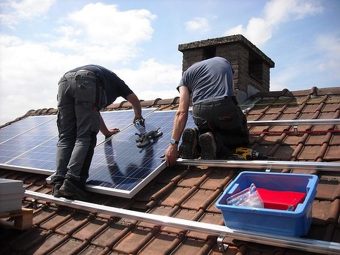
New ideas struggle for acceptance. We are all fascinated by new technology but repelled by it at the same time. Peer pressure is a big factor in breaking down the barriers to new ideas. Early adopters lead the way, then the masses follow. Google is taking advantage of our human foibles by tweaking its program to show people which houses in their neighborhood have rooftop solar systems installed.
Electric car advocates know the process well. People who have never tried an electric car have a raft of questions. What if I run out of range? What if the battery fails? What if it catches on fire? What if I want to drive to the coast tomorrow? Fossil fuel companies play on those fears to cement their competitive position.
But once a neighbor parks an electric car in the driveway, the dynamic changes. “It happens at the street level, it happens within zip codes, it happens within states. It seems to be a common feature of human decision-making that crosses many boundaries,” says Kenneth Gillingham, a professor of economics at Yale University. It has nothing to do with age, education, income, or whether your parents voted for Ralph Nader. Suddenly, once one person has something, everyone wants it.
Google’s Project Sunroof now adds a red dot to every roof that has a solar system in the neighborhood. Voila! Just by doing that, having rooftop solar doesn’t seem to strange anymore. Project Sunroof is a free online tool that makes it easy for people to obtain and use rooftop solar panels. With 60 million homes in its data base, it shows people how much sun hits their roof and how much solar panels could save them every month.
Project Sunroof was started in 2015 by Carl Elkin, a Google engineer. “It highlights that, for many people, solar is often free. In many cases, including for my house, solar is better than free,” Elkin says. “People want to know: ‘What if there’s some hidden gotcha in the contract? Usually there isn’t. ‘Does this work for other people like me? Is solar really viable in my neighborhood?”
With Project Sunroof, “You can zoom around through your town and understand how common solar is in your neighborhood. And many people have found — Wow, there is a lot more solar in my neighborhood than I’d realized. We want people to realize solar is absolutely part of the fabric of American life,” Elkin says.
Being able to see solar panels on a roof creates a big increase in interest from neighbors, but not all rooftop solar systems are visible from the street. The new Project Sunroof feature “tells you that people nearby have installed solar panels even if you can’t see them from the road,” Gillingham says.
“It creates a social norm around solar panels,” he says. “When many people have solar panels around you, it’s a normal thing to do. You’re not going out on a limb by having a company come out and look at your rooftop.”
Elkins says, “We want people to realize solar is absolutely part of the fabric of American life. Out of these many houses, each saving money, comes one solution to the environmental problem. Out of many, one. That’s a very American idea.”
Source: cleantechnica.com



